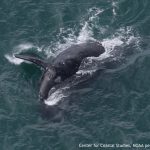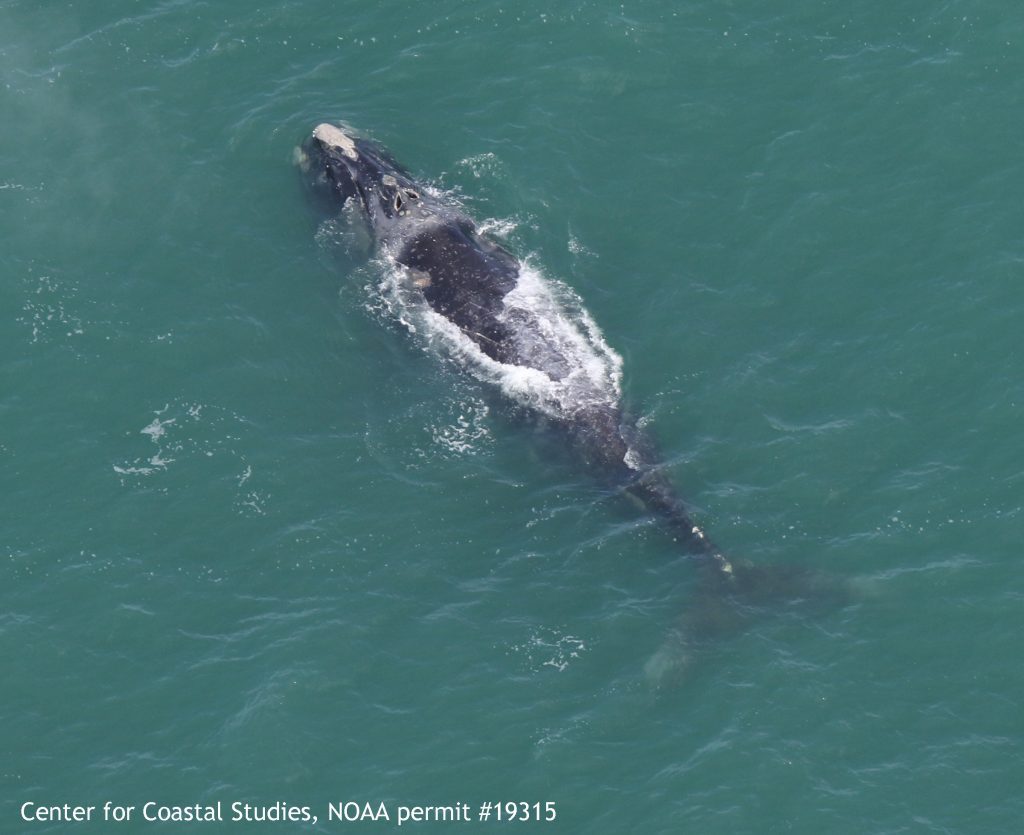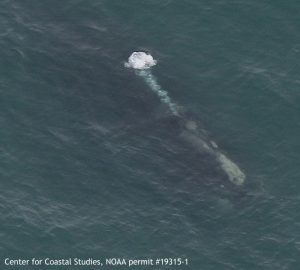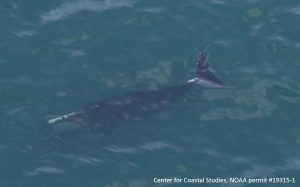Field Notes March 2018
 Ever wonder what can be found just East of Cape Cod Bay? We did a survey out this way on March 1st looking for right whales. We try to do these surveys every month just to see what is going on, but we have to wait for the calmest days as the waters are usually a little rougher offshore than they are inside the protected waters of Cape Cod Bay. If it’s too rough, we risk not spotting the animals that we’re looking for.
Ever wonder what can be found just East of Cape Cod Bay? We did a survey out this way on March 1st looking for right whales. We try to do these surveys every month just to see what is going on, but we have to wait for the calmest days as the waters are usually a little rougher offshore than they are inside the protected waters of Cape Cod Bay. If it’s too rough, we risk not spotting the animals that we’re looking for.
Today, the weather was perfect and the sea state was almost glassy calm at times. What did we see? Well, we found a lot of dolphins, both common and Atlantic white-sided scattered about the entire survey area. Sometimes it can be tricky to tell the difference between the two species, however, if we get a good look at them, we can use their pectoral fins or flippers to tell the species apart. The fins of common dolphins are a lighter color and are therefore visible from the plane, whereas the fins of Atlantic white-sided dolphins are dark and we cannot see them. Click on the pair of photos above to see if you can tell the difference too.
One of our pilots was very excited to see his first fin whale! We shared in his excitement and watched as the whale came slowly to the surface. It was clearly visible in the calm waters and Brigid was able to get some fantastic shots of this individual. We also got a great look at two humpback whales traveling slowly together. These were our first humpback whale sightings of the season and we were excited to be able to get photos of them as well.
For all of our sightings on this perfect day, we were still unable to find any right whales offshore. It appears that they’re congregated in Cape Cod Bay. We’ll let you know what happens next survey and who all we find in Cape Cod Bay as we won’t be doing another Eastern Shore Survey until April.
– Alison
AERIAL SURVEY 3/12/18
With two Nor’easters last week, it’s been nearly two weeks since we have been able to survey Cape Cod Bay. This has left us with a lot of questions as to who was sticking around and how many whales we’d find next time we flew. With only a small window on Monday before a third Nor’easter hit on Tuesday, we went out for an early survey, hoping to finish before winds started picking up in the afternoon.
Taking off out of Provincetown Municipal Airport, we flew down the back (i.e. eastern) side of Cape Cod. Seeing nothing there, we crossed over the elbow section of the cape, from Chatham, Harwich, past Hyannis to start surveying Cape Cod Bay from the south, working our way north. We noticed right away the past week’s turbulent weather has had an effect on the water itself. With high winds stirring up waves, there was a lot of mixing of bottom layers, causing high turbidity in the waters. This means we couldn’t see down into the water very deep, which becomes important since it lessens the chance of finding and tracking whales when they are subsurface.
Luckily, we did manage to find whales, over 30 in total. Some of these individuals have been hanging around for a while now; others were new to us this season. Interestingly, we had Eg #3191 in yet another surface active group (SAG) early in the day. He’s been seen on four of our previous flights this year, and we saw him in 2 different SAGs so far this season. On this last survey, he was in a SAG with Eg #3530 (Ruffian) and Eg # 2791.
Ruffian is exciting because it was our first sighting of him from the plane. When R/V shearwater had Ruffian from the boat on March 1st, we were surveying East of Cape Cod and so missed seeing one of our favorite survivors from air. Seeing #3191 in a SAG with #2791 was exciting because this is the second time this season that they were in surface active groups together. While these associations are not long lasting, the fact that they are in them over several weeks is interesting, and we hope that means we can count on #2791 to calve next year.
Another familiar face was Salem, Eg #3617. He is an adult male who we had in the bay already this year at the end of January, and this time he was indulging in unique behavior. He was continuously swimming on his side, slapping his pectoral flipper on the surface of the water and blowing bubbles under water. Such behavior is more common from humpbacks but getting to see some variation to the usual feeding behaviors seen in Cape Cod Bay was a treat.
Unfortunately, we also had a new whale that didn’t look so great. Eg #1711, a familiar face in previous years, was a mom last year and brought her calf here. Unfortunately, she looks emaciated and we hope feeding here will help her regain some of her fat stores, likely depleted by the energy that went into rearing last year’s calf.
With more high winds and winter storms headed our way, we’ll keep our fingers crossed that we can get out again soon enough and hopefully whales will be skim feeding regularly by then.
– Amy
AERIAL SURVEY 3/20/18
Our weather windows have been miniscule lately because of incessant Nor’easters, and this week was no different. After over a week of not flying, we were able to complete a survey in the calm before the storm (that was forecasted to start Wednesday). We took off a little later (i.e. 0930) on Tuesday to allow for winds and sea states to decline, but it wasn’t late enough as we encountered high beaufort seas throughout the beginning of our flight.
We began our survey in the north and worked our way south through Cape Cod Bay. All was quiet until our fifth track line, where we encountered a group of 3 right whales subsurface feeding. Unfortunately, the sea height was still pretty high and the water was turbid, so taking images was a little challenging. However, Amy rose to the occasion and after successfully photographing them, we continued on.
We did not see another right whale until trackline 7, and from then on we had consistent sightings of right whales mainly scattered throughout the center of the bay, resulting in 25 individuals total. Most of them were subsurface feeding, but we did observe some cool behaviors like breaching, underwater exhalation (check out bubbles), and social activity.
Of those whales, many were new for the season! This included one of my personal favorites: EgNo 1271 “Dropcloth.” Dropcloth is an adult male named for his speckled appearance (akin to a drop cloth used for painting) and was first seen in 1978 (!), making him at least 40 years old. Though he has been a regular in Cape Cod Bay since 2013, we didn’t observe him here last year so it’s nice that he’s back.
Another new individual for us that was first observed on March 12th and again yesterday is EgNo 1960. This adult male was first seen in 1989, and over his nearly 30 year sightings history he has only been seen inside Cape Cod Bay once- and that was in 2011. A new female for the season is EgNo 4190. This juvenile was born in 2011, and has been sighted in the bay every year since 2015.
We’re hoping that we’ll get another survey in soon as we approach our historically busy part of the season and that we’ll see some new faces (and fingers crossed a calf).
– Brigid
AERIAL SURVEY 3/28/18
The winds finally calmed on Wednesday and the aerial survey team took off early from Provincetown Municipal Airport. The sea state made it possible to see any slight disturbance on the water, so spotting whales was a lot easier than it has been on past surveys. Even the whales’ behavior changed from having predominantly deep diving whales on past surveys to seeing mostly subsurface feeding today. In total we spotted 26 whales, and a lot of them were new individuals that we haven’t yet seen this season.
The survey got off to a great start with a right whale sighting before we even got to our first track line. The animal then disappeared for quite some time and we started wondering while we circled if we would ever find it again. Then we spotted the whale flying through the air in a breach. This all happened too quickly for photographs, but once the whale resurfaced, Brigid immediately identified it as EgNo 3540 “Black Heart,” although she has a new scar on her back that wasn’t there last year. “Black Heart” is the 2005 calf of “Wart”, EgNo 1140 and is a whale that we often see in Cape Cod Bay. It’s great to have her back this season.
“Ergo,” EgNo 1317 was another very exciting find of the day. He is an adult male that we often see feeding in Cape Cod Bay, but has had quite the year since we last saw him in April 2017. Ergo was seen entangled in fishing gear last summer with line wrapping around his mouth and extending down towards his tail. At the time of this sighting, a response to free “Ergo” from this fishing gear was not possible, but luckily the whale was seen without fishing gear a few weeks later. “Ergo” is one of the lucky animals that was able to free himself from gear. We were able to get great images of this whale with the clear water and calm sea state and can confirm that no can be seen on the whale. Unfortunately, we know that this was not Ergo’s first entanglement in fishing gear, as he had indicative scarring even prior to his 2017 entanglement. He now joins the group of over 40 percent of North Atlantic right whales that have been entangled more than once in their lives. Over 80 percent have been entangled at least once.
We do our best to monitor the health and behavior of the whales we document and were really concerned with one of our sightings. We spotted and documented a whale that was resting at the surface while breathing, but with its tail pointed down to where we couldn’t see it. Having never seen this kind of behavior for such a long period of time and concerned that the whale might be caught in fishing gear, we called the Marine Animal Emergency Response team based at the Center for Coastal Studies to come and examine the whale. Luckily, not long after the call, but after 45 minutes of circling, the whale finally dove, showing its tail but no gear. Hurray! We called the rescue team to let them know and moved on. On the next track line, looking back, we saw an enormous splash and shortly after a breaching whale. Here was the whale (EgNo 2304) that didn’t move for so long, repeatedly breaching once we had left. Oh the joys of field work!
If you see an entangled whale, call 1-800-900-3622.
– Alison
AERIAL SURVEY, 3/29/18
Having flown Cape Cod Bay yesterday, and another great day of weather today, we decided to focus our efforts on the area east of Cape Cod Bay. Our normal Eastern Shore surveys are typically done once a month or as deemed necessary when trying to find where right whales may be present when they are not in CCB. Seeing as we’re expecting a peak in right whale density to start occurring in the next couple of weeks, we wanted to make sure we weren’t missing any that were on their way into the bay or that choose to never come in.
We flew track lines that were further north than our usual survey to help cover area that has been busy detecting right whale calls in recent weeks. Knowing whales were likely transiting, if not aggregating in that area recently, we were hoping to find some right whales out there. This evidence would allow us to compare them to those who have already been seen in CCB or may be coming in to feed in April. Doing so could give insight to fluctuations of whales in the bay intra-seasonally.
Alas, we didn’t have any luck spotting right whales, but there was definitely an abundance of other marine mammals. We had a handful of fin whales, humpbacks and sei whales. The shining star of the surveys though were definitely the minke whales and dolphins, of which we saw 22 and 207 of respectively. Some of the Atlantic white sided dolphins were observed leaping from the water in impressive displays of acrobatics.
When we transited over the bay back to the airport, we were impressed by the sea state that registered as a stunning zero on the Beaufort scale. We’re hoping for those conditions on our next survey!
-Amy









